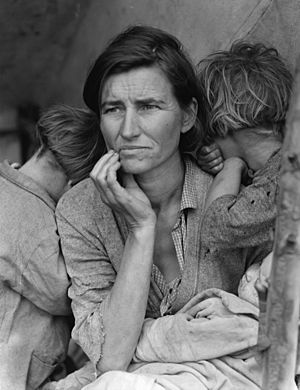Hunger facts for kids

In politics, humanitarian aid, and the social sciences, hunger is a condition in which a person does not have the physical or financial capability to eat sufficient food to meet basic nutritional needs for a sustained period.
In the field of hunger relief, the term hunger is used in a sense that goes beyond the common desire for food that all humans experience, also known as an appetite. The most extreme form of hunger, when malnutrition is widespread, and when people have started dying of starvation through lack of access to sufficient, nutritious food, is called famine.
In history
Throughout history, portions of the world's population have often suffered sustained periods of hunger. In many cases, hunger resulted from food supply disruptions caused by war, plagues, or adverse weather. In the decades following World War II, technological progress and enhanced political cooperation suggested it might be possible to substantially reduce the number of people suffering from hunger. While progress was uneven, by 2014, the threat of extreme hunger had receded for a large portion of the world's population. According to the FAO's 2021 The State of Food Security and Nutrition in the World (SOFI) report, the number of people suffering from chronic hunger began to rise gradually between 2014 and 2019. In 2020, due to the COVID-19 pandemic, there was a massive increase, resulting in nearly 770 million people suffering from malnutrition.
While most of the world's people continue to live in Asia, much of the increase in hunger since 2015 occurred in Africa and South America. The FAO's 2017 report discussed three principal reasons for the recent increase in hunger: climate, conflict, and economic slowdowns. The 2018 edition focused on extreme weather as a primary driver of the increase in hunger, finding rising rates to be especially severe in countries where agricultural systems were most sensitive to extreme weather variations. The 2019 SOFI report found a strong correlation between increases in hunger and countries that had suffered an economic slowdown. The 2020 edition instead looked at the prospects of achieving the hunger related Sustainable Development Goal (SDG). It warned that if nothing was done to counter the adverse trends of the past six years, the number of people suffering from chronic hunger could rise by over 150 million by 2030. The 2021 report reported a sharp jump in hunger caused by the COVID-19 pandemic.
Hunger relief organisations
Many thousands of hunger relief organisations exist across the world. Some but not all are entirely dedicated to fighting hunger. They range from independent soup kitchens that serve only one locality, to global organisations. Organisations working at the global and regional level will often focus much of their efforts on helping hungry communities to better feed themselves, for example by sharing agricultural technology. With some exceptions, organisations that work just on the local level tend to focus more on providing food directly to hungry people. Many of the entities are connected by a web of national, regional and global alliances that help them share resources, knowledge, and coordinate efforts.
Images for kids
-
WFP's HungerMap LIVE monitors food security and predicts the status of crisis-hit areas where data is limited, World Food Programme, 2021
-
Increased use of irrigation played a major role in the Green Revolution.
-
Affected areas in the western Sahel belt during the 2012 drought.
-
Volunteers pass out food items from a food bank run by Feeding America
-
A soup kitchen in Montreal, Quebec, Canada in 1931.
See also
 In Spanish: Hambre para niños
In Spanish: Hambre para niños







